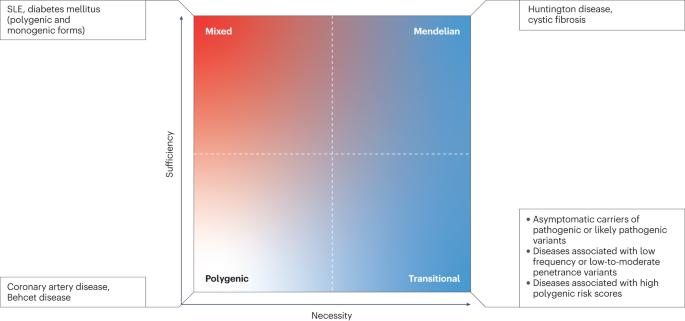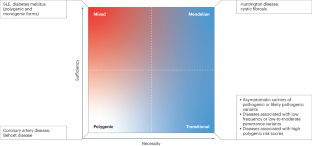Genetically transitional disease: conceptual understanding and applicability to rheumatic disease
IF 29.4
1区 医学
Q1 RHEUMATOLOGY
引用次数: 0
Abstract
In genomic medicine, the concept of genetically transitional disease (GTD) refers to cases in which gene mutation is necessary but not sufficient to cause disease. In this Perspective, we apply this novel concept to rheumatic diseases, which have been linked to hundreds of genetic variants via association studies. These variants are in the ‘grey zone’ between monogenic variants with large effect sizes and common susceptibility alleles with small effect sizes. Among genes associated with rare autoinflammatory diseases, many low-frequency and/or low-penetrance variants are known to increase susceptibility to systemic inflammation. In autoimmune diseases, hundreds of HLA and non-HLA genetic variants have been revealed to be modest- to moderate-risk alleles. These diseases can be reclassified as GTDs. The same concept could apply to many other human diseases. GTD could improve the reporting of genetic testing results, diagnostic yields, genetic counselling and selection of therapy, as well as facilitating research using a novel approach to human genetic diseases. Beyond the traditional classification of monogenic or complex, many genetic diseases can be considered genetically transitional disease. In this Perspective, the authors consider the application of the genetically transitional disease model to rheumatic diseases and the potential implications for patient care, genetic counselling and research.


基因过渡性疾病:对风湿病的概念理解和适用性。
在基因组医学中,基因过渡性疾病(GTD)的概念指的是基因突变是导致疾病的必要条件,但并非充分条件。在本视角中,我们将这一新概念应用于风湿病,通过关联研究,风湿病与数百种基因变异有关。这些变异处于效应大的单基因变异和效应小的常见易感等位基因之间的 "灰色地带"。在与罕见自身炎症性疾病相关的基因中,已知许多低频率和/或低先验性变异会增加对全身性炎症的易感性。在自身免疫性疾病中,已发现数百个 HLA 和非 HLA 基因变异是中度至中度风险等位基因。这些疾病可被重新归类为 GTD。同样的概念可适用于许多其他人类疾病。GTD 可以改进基因检测结果的报告、诊断结果、基因咨询和治疗选择,并促进采用新方法治疗人类遗传疾病的研究。
本文章由计算机程序翻译,如有差异,请以英文原文为准。
求助全文
约1分钟内获得全文
求助全文
来源期刊

Nature Reviews Rheumatology
医学-风湿病学
CiteScore
29.90
自引率
0.90%
发文量
137
审稿时长
6-12 weeks
期刊介绍:
Nature Reviews Rheumatology is part of the Nature Reviews portfolio of journals. The journal scope covers the entire spectrum of rheumatology research. We ensure that our articles are accessible to the widest possible audience.
 求助内容:
求助内容: 应助结果提醒方式:
应助结果提醒方式:


